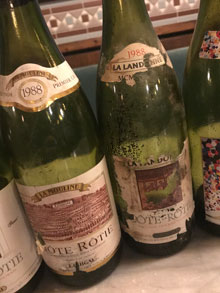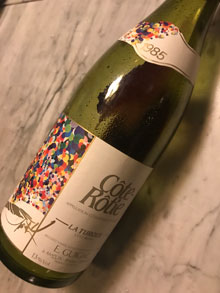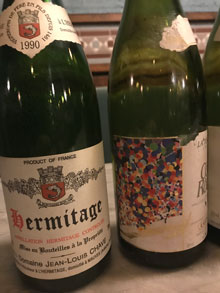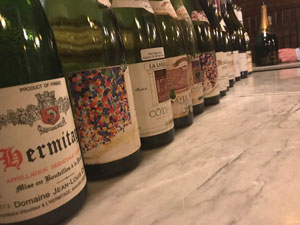After my week in Europe, I went straight to San Francisco. La Paulee was in town, and a bunch of Burgundy lovers were bouncing off the best restaurants’ walls all week long. There were three distinctively noteworthy dinners I was fortunate enough to attend, beginning with an evening at Saison, which The Jackal had bought out for his clandestine operations. Our most generous host organized a spectacular dinner made all the more spectacular by the generosity he commanded from all of his guests.
I Drank My Way Through, San Francisco, Part I
The first flight was one of Coche-Dury. Always a good way to start the night! It was supposed to be all Meursault Perrieres, but I will get to that in a minute. The first wine was a 2010 Coche-Dury Meursault Perrieres, which was icy city and full of minerals and spice. While a bit immature, there was still some tangy yellow fruits to this tense and frigid (served too cold) wine. However, it was a bit awkward and ‘tight’ per Dr. Love, in need of more time, and there is no doubt in my mind that it will eventually climb the point scale (94+).

Cochy-Cochy Koo
The 2004 Coche-Dury Meursault Perrieres was in a much better spot, much fleshier and open for business. There was delightful spice and a touch of glue to this wintry mix, along with sweet, bright, yellow Coche fruit. A touch of kernel and benevolent dust rounded out this rich and vimful white. This was luscious and great, right in its sweet spot (96).
The third wine was brought by me, and supposed to be a 2001. Well it was a 2001, just a 2001 Coche-Dury Corton Charlemagne instead. Surprise, surprise. I love those $5000 picking errors. To make matters worse, one of the bottles was corked; of course, it was the bottle I got. Kill me now. I did have a sip of the other bottle, which was fantastic, but not enough to fully depict (DQ).
The next flight was one of Ramonet, Montrachet, of course. The 2007 Ramonet Montrachet had a sweet and very sugary nose with hints of pepper, mint and oil. It was a little weird with its fruit, and I couldn’t quite pin it down. It tensed up a bit in the glass, and minerals emerged on its stony palate. It was long, zippy and dry. Jetski wasn’t a big fan (95).

Mucho Montrachet
The 2005 Ramonet Montrachet was unfortunately oxidized (DQ). The 2002 Ramonet Montrachet was not. It had a smokehouse nose with corny, sweeter fruit. It was quite oily in its aromas, showing white ice and more smoke. There was a big anise streak and lots of structure to this intense wine. It was almost as if a twist of vodka was in there! It was almost too young, more intense than the 2007 for sure (96+).
A magnum of 1999 Ramonet Bienvenues Batard Montrachet was a last second substitute, I think, and it didn’t stack up to the Montrachets being served last in the flight. It just wasn’t in the same league, more waterfall and alley, and lighter for a 1999 in general. Jetski found it ‘thin, and its finish is clipped.’ Tell us how you really feel, Jetski : ) It got better when I ran out of Montrachet lol (93M).
A flight of DRC Richebourg was next, and it set a great bar for the reds. First up was the 2007 DRC Richebourg, a vintage that in general is great to drink young for the Red Burgs. It was sweet and classic ’07, ‘fresh and crisp, begging you to drink it,’ Dr. Love aptly apprised. It was delicious and long with nice, light structure on its finish with a bit of zip and more length than I expected. It was definitely flirting with outstanding, but after going through the rest of the flight, it lost a step. ‘The ladybugs came in,’ Who Shot JR noted. He was right, and I was up and down my own point scale, settling on a benevolent (94).

Fab Five Richebourgs
The 2001 DRC Richebourg that followed showed spectacularly well, making up for the last time I had this wine. Bottle variation, it happens. There was great perfume and lots of red fruit to this rich and oily red. It was very concentrated with lots of rose and oil components. Rich, long and tasty, I noted it was even better than the ’01 La Tache I just had in Miami. I don’t say Riche is better than LT often; again, it could just be a bottle thing. Rich and saucy, everyone was a fan of the 2001. The topic of aging wine too long came up as a compliment to drinking this ’01 now; let’s just leave it at that (96).
The 1991 DRC Richebourg that followed had more celery soda action, along with cherry oil and ‘olive’ per Dr. Love. It was brothy and full of bouillon. Jetski thought it was a touch advanced, but The Jackal thought it was the wine of the night. There was a touch of kink to its flavors on the red side, and it became a bit jammy on the palate. I wanted more from it, given how great the 1991 vintage can be (95).
We continued onwards with a magnum of 1979 DRC Richebourg. Its nose was a bit balmy with a stewy and tea-like personality. Someone noted its ‘third stage of evolution.’ There was definitely soil and wet forest to go with its blacker fruits. However, its palate was delicious, showing great sweetness and balance. There was flesh and medium grit to this lip smacking wine. While the nose was all about the mushroom and tree bark, the palate was all about the delicious. A tale of two wines, indeed (96M).
The 1966 DRC Richebourg was a tale of two bottles. Well, that may not be entirely fair. I got the dregs of one bottle, so I couldn’t even deal thanks to the mismanaged pour. The second bottle was super tasty, with loads of red oil and a touch of mint. I only had a small sip or two, however (96).
Next up was a flight for lovers, especially those of Roumier and Mugnier. The 2009 Roumier Chambolle Musigny Les Amoureuses was ‘so primal’ per Dr. Love. It was a monster, one that wasn’t ready. It was black as hell, so much so it was tough to enjoy. Jetski observed, ‘it doesn’t mean anything,’ as it was tough to evaluate the wine at this age. Roumiers need more time than most. It was so concentrated and so young, clearly in need of more time (95+).
The 2005 Roumier Chambolle Musigny Les Amoureuses was a bit better, just starting to show. There was nice red fruit here, along with what I put as ‘some of that ’99 dirt.’ I was referencing the ’99 Roumier Musigny I had the night prior in London, of course. The 2005 was just starting to shed its skin, flex its muscles, insert your own analogy here. You better because I can’t read the rest of my notes lol (96+).

In Love
Even though it was about 5am on my internal clock on that day, I had one good note left in me for a 2002 Mugnier Chambolle Musigny Les Amoureuses. The Mugnier was sweet and delicious, clearly a lighter style than the Roumier. This wasn’t a negative as the Mugnier went down so easy. Another concurred it was showing much better. Its elegance and style seduced, combining with gorgeous purple flowers and an oh so tasty finish (96).
My internal alarm clock failed to go off, so the last three (yes three!) flights saw me abridging my notes significantly. The first was a flight of rare Fourrier Griottes Chambertin, and we were joined by Jean-Marie Fourrier for dinner, by the way.

Groovy Griottes
| 1. | 2012 Fourrier Griottes Chambertin | (94) |
| 2. | 2011 Fourrier Griottes Chambertin | (95) |
| 3. | 2010 Fourrier Griottes Chambertin | (97+) |
| 4. | 2009 Fourrier Griottes Chambertin | (92) |
The 2012 was purple and primary, ‘pretty and beautiful’ per the Somm. It was tasty, and I liked it, but a bit young. The 2011 really impressed, quite drinkable already, and showing that early ’11 approachability. It had some nice zip, however. The 2010 was the best of the flight and a superb wine. It had so much acidity and length. It got a, ‘Great!!!’ It was also my highest rated wine of the night. The 2009, on the other hand, was a bit disappointing. It had the least fire in its soul, and it was heavy and a bit cloying. Its flavors were also a touch dirty.

Leroy Latricieres

Richebourg Taking Charge
| 1. | 2001 Leroy Latricieres Chambertin | (94) |
| 2. | 2000 Leroy Latricieres Chambertin | (95) |
| 3. | 1996 Leroy Latricieres Chambertin | (96) |
| 4. | 1990 Leroy Latricieres Chambertin | (95) |
| 5. | 1990 Leroy Richebourg | (97) |
The signature, deep, dark spice of Leroy was evident immediately. Brian hailed it as ‘the best flight.’ The 2001 was solid but lost a step in the glass. The 2000 outboxed its weight class; this was so rich for a 2000. It also outclassed the 2001 with its deep, heavy, rich and pleasing fruit. The 1996 was classic. It has always been a great vintage for Leroy as her style plays well into the highly acidic profile of 1996. The 1990 got another ‘solid’ from me, but the Richebourg seized hold off the flight immediately. It was just better than all the rest.
There was also one last flight of Krug. I had thrown in the towel already, but here are some scores.

No Mas
| 1. | 1996 Krug Clos d’ Ambonnay | (95) |
| 2. | 2002 Krug Clos du Mesnil | (96) |
| 3. | 1990 Krug Clos du Mesnil | Oops, Missed It |
| 4. | 1989 Krug Clos du Mesnil | (DQ) |
| 5. | 1988 Krug magnum | (96M) |
It was kind of late, and if it wasn’t 7AM for me, I might have rallied. But tomorrow was another day, and the legendary Martine Saunier was waiting in the wings with some Jayer from her cellar…
In Vino Veritas,
JK






















